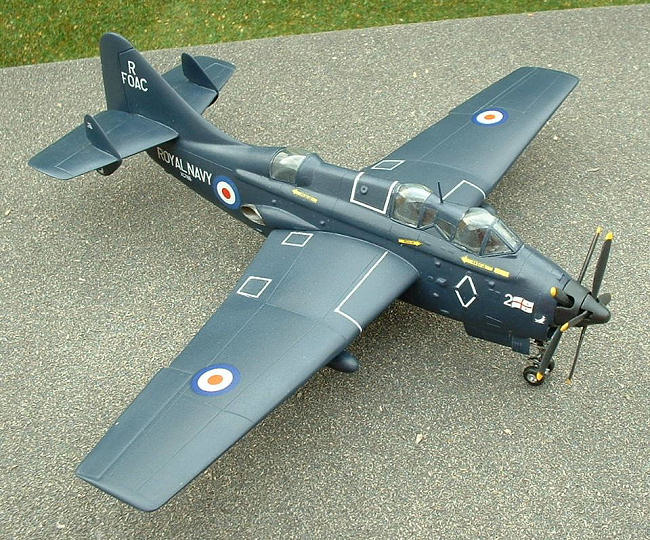
| KIT #: | ? |
| PRICE: | $out of production |
| DECALS: | They exist |
| REVIEWER: | Pat Cauthery |
| NOTES: | COD.4 conversion. Aeroclub seat used. |

| HISTORY |
Originating from
a 1946 specification to produce a two seat anti-submarine aircraft, the Fairey
Gannet was put into super priority production in 1951, with the first production
Gannet AS1 being flown in 1953. Equipped with two Armstrong Siddely Mamba
turbojets driving contra rotating propellers, the Gannet
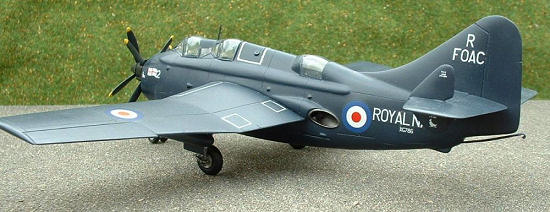 made the first ever
deck landing by a propeller turbine aircraft, and featured a retractable radome
in the rear fuselage. The finlets on the tailplane were added as a result of
instability problems caused by lowering the radome in flight.
made the first ever
deck landing by a propeller turbine aircraft, and featured a retractable radome
in the rear fuselage. The finlets on the tailplane were added as a result of
instability problems caused by lowering the radome in flight.
The definitive anti-sub variant was the AS4 which had uprated engines and was exported to Australia (in fact the Aussies got AS1s), West Germany and Indonesia. By 1960 all the anti-sub Gannets in the Fleet Air Arm had been replaced by helicopters. The Gannet also had two training variants (T2 and T5), an ECM version plus the virtual total rebuild in its AEW3 guise with a large belly radome. Finally a Carrier-on-Deck (COD) variant existed which had the radome deleted and most of the electronics removed. The COD4 was used to ferry VIP passengers and freight to and from carriers. The COD Gannet was in fact the last to serve in the FAA, being used on HMS Ark Royal until its decommissioning in 1978.
| THE KIT |
This kit has a long and illustrious history, originally being produced by Frog and then by Novo after the demise of Frog. It has also been produced by Revell (with a nice set of decals) and by several other East European manufacturers.
My version was a
no-name Novo copy, and was produced in rather brittle dark brown plastic. I also
had a copy moulded in black 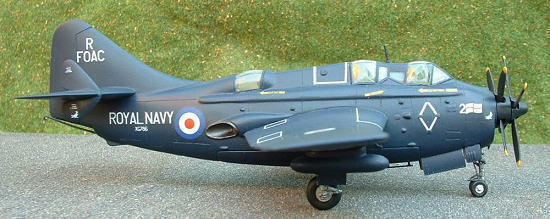 which was in a worse state but it did end up
donating some parts. The mould looked like it had been used to mine salt in
Siberia with in particular some surface detail being obliterated from the port
side of the fuselage. Ejector pins had also partially pulverised some of the
detail causing round stress fractures on the fuselage. Flash was everywhere, the
decals were printed on toilet paper and all-in-all this was a somewhat
underwhelming kit. On the plus side, the poor moulding meant that the trailing
edges of the flying surfaces were actually quite thin although care was needed
in handling these for obvious reasons.
which was in a worse state but it did end up
donating some parts. The mould looked like it had been used to mine salt in
Siberia with in particular some surface detail being obliterated from the port
side of the fuselage. Ejector pins had also partially pulverised some of the
detail causing round stress fractures on the fuselage. Flash was everywhere, the
decals were printed on toilet paper and all-in-all this was a somewhat
underwhelming kit. On the plus side, the poor moulding meant that the trailing
edges of the flying surfaces were actually quite thin although care was needed
in handling these for obvious reasons.
However, inspired by Adam Rehorn’s great rendering of a Gannet trainer on the IPMS London website, I pressed ahead and decided to convert mine to a COD4 variant on HMS Ark Royal as featured on Modeldecal Sheet #18 , and also picked up the Aeroclub white metal set for the Gannet. This comprises a new front end, undercarriage, props, seats, vac canopy and assorted other goodies.
| CONSTRUCTION |
Construction
started with hacking out the solid cockpit and radar operators area and adding
some plasticard cockpit floors for the white metal seats to rest on. I drilled
the engine exhausts and also cut out a slot at the front end in order to site
the white metal base for the nose gear. The gear doors for the nose wheel are
comprised of two small (supplied by Aeroclub) and two larger doors, all or which
I cut away. This made fitting the base plate much easier, but when inspecting
pictures of operational Gannets, it
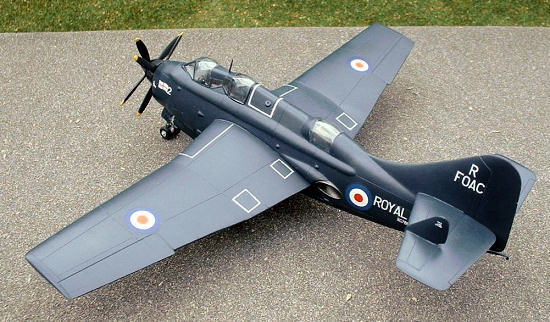 looks like the larger of the sets of doors
are always in the closed position when on the ground (presumably they have to
open at least twice in every flight!). As I had hacked mine away I had to
portray them in the open position – perhaps simulating a hydraulic failure!! The
gear doors I used themselves originally belonged to an Fw200, which when cut in
half were more or less the correct size.
looks like the larger of the sets of doors
are always in the closed position when on the ground (presumably they have to
open at least twice in every flight!). As I had hacked mine away I had to
portray them in the open position – perhaps simulating a hydraulic failure!! The
gear doors I used themselves originally belonged to an Fw200, which when cut in
half were more or less the correct size.
The fuselage halves were joined and the white metal seats were added. Aeroclub provide instrument panels for all three Gannet crewmembers. I presumed that the radar operators screen would not have been present in the COD Gannet so left this off. When it became apparent that I was not going to be able to use the vac canopy and would have to use the Frog/ Novo original clear parts I decided just to add a couple of bits of card to represent instrument panels and sprayed the whole interior tyre black.
The radome is deleted in the COD variant, so this was carved off and the hole plugged with some plasticard and Mr Surfacer 500 and then sanded flush with the rest of the lower fuselage.
At this point I attempted to rescribe the panel lines by tracing the raised lines with the back of an X-Acto blade. As the original lines were so poorly moulded, the end result was a horrible mess so I filled most of my lines and tried again using Dymo tape. This was tricky for lines running top to bottom because of the shape of the Gannet’s fuselage, but I ended up reasonably satisfied albeit my job was by no means perfect.
One of the small intakes on the fuselage side had been mashed by an ejector pin. I sanded the area smooth and replaced it by cutting the very tip from a half drop tank from my spares box.
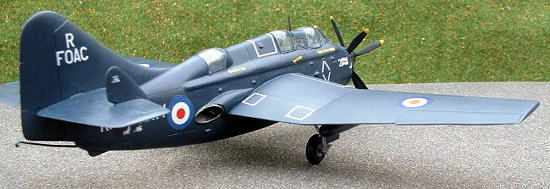 The white metal
front end replaces the kit part and is a huge improvement, giving some much
needed depth to the frontal intake area. With some careful placement, a lot of
Mr Surfacer 500 and even more sanding I was delighted at how well the new front
blended in to the rest of the kit.
The white metal
front end replaces the kit part and is a huge improvement, giving some much
needed depth to the frontal intake area. With some careful placement, a lot of
Mr Surfacer 500 and even more sanding I was delighted at how well the new front
blended in to the rest of the kit.
There are no main gear wheel wells at all in the wings and I carved these out. I suppose I should have boxed these in but I left them and just added a small square of plastic card in which I would later drill a hole to receive the white metal main gear.
The wings mate with the fuselage very nicely and I just used a smear of white glue to fill hairline cracks at the join.
The small finlets had a desire not to sit perpendicular to the tailplane and I ended up snapping one off in my attempts to bend them into the right position. A replacements was sourced from my black Gannet and they are still not perfect to be truthful.
The canopies
were a story in themselves. I managed to ruin both Aeroclub vac canopy (by over
zealous trimming) and a Falcon one (by dropping it on the floor and then as I
stood up to look for it realising that it had fallen precisely under my foot).
The canopies provided in my two Gannet kits were no good – one was almost yellow
and the other had a big craze mark that refused to polish out. I ended up buying
a cheap box containing two more Gannet kits (one Frog, one Novo) and hoping that
I would be able to salvage something. In the end the Frog canopy was OK and was
used. It is still very thick and lens-like and you can see little or nothing of
the cockpit beneath. But now I have three Gannet airframes and no canopies –
any donations or ideas gratefully received!! Gannet “Mistel” or “Zwilling”
anyone?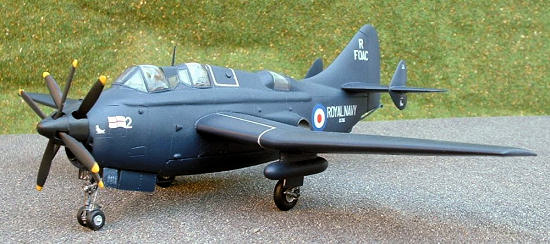
COD Gannets often carried drop tanks. After searching the spares box without luck for something suitable I ended up raiding my Revell Hurricane for its drop tanks which were approximately the right shape and size. I subsequently discovered you can buy 1/72 resin drop tanks for the COD Gannet, albeit for around the same price as the Hurricane kit. I had to do a fair bit of filling to fair the pylons into the underside of the Gannet’s wing.
The final touches were an underbelly aerial made with fine plastic rod and an aerial mast from spare photo-etch.
| COLORS & MARKINGS |
COD Gannet’s were painted in RAF Blue/ Grey overall. I followed the instructions in a Fujumi Lynx kit and mixed two parts of Gunze H326 (Blue FS15044) with one part of Gunze H328 (Blue FS15050). I was quite pleased with the resulting colour.
The Modeldecal sheet was very old and the larger decals wrinkled horribly on application. Setting solutions actually seemed to make the problem worse, so I resorted to waiting until the decals were nearly dry and carefully rubbing down the wrinkles with my thumb.
| CONCLUSIONS |
This was a seriously rough
kit - the moulds appear to have taken a real pounding and the deterioration
between a Frog original 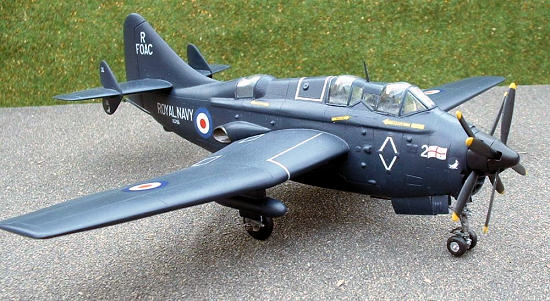 and the East-European repops is marked. If you want to
make an injection moulded Gannet I would recommend searching out a Frog
moulding, which are not necessarily any more expensive than the re-boxings
(Since writing the review I have read that Trumpeter are due to release a 1/72
Gannet AS1/4 later this year. Probably this will see a million Novo Gannets
being consigned to the trash although it will be slightly sad to see this
venerable kit finally superseded and perhaps they will still be of use for those
who wish to convert them to T2/T5/COD variants). Revell’s more recent reboxing
of this kit may have cleaned up the moulds but I can’t speak from experience.
You do get useable decals with the Revell kit of course.
and the East-European repops is marked. If you want to
make an injection moulded Gannet I would recommend searching out a Frog
moulding, which are not necessarily any more expensive than the re-boxings
(Since writing the review I have read that Trumpeter are due to release a 1/72
Gannet AS1/4 later this year. Probably this will see a million Novo Gannets
being consigned to the trash although it will be slightly sad to see this
venerable kit finally superseded and perhaps they will still be of use for those
who wish to convert them to T2/T5/COD variants). Revell’s more recent reboxing
of this kit may have cleaned up the moulds but I can’t speak from experience.
You do get useable decals with the Revell kit of course.
I was somewhat fearful of the white metal nose but it was a relatively simple job to fit – for those used to making kits out of the box (like myself), this would be a reasonably simple and modest introduction into the world of “conversions”. The white metal landing gear are an infinite improvement on the originals.
July 2006
| REFERENCES |
Scale Aircraft Modelling Vol8 No.10 July 1986
Royal Navy Aircraft Since 1945 – Ray Williams
http://ipmslondon.tripod.com/aircraftreviews/id20.html
If you would like your product reviewed fairly and fairly quickly, please contact the editor or see other details in the Note to Contributors.